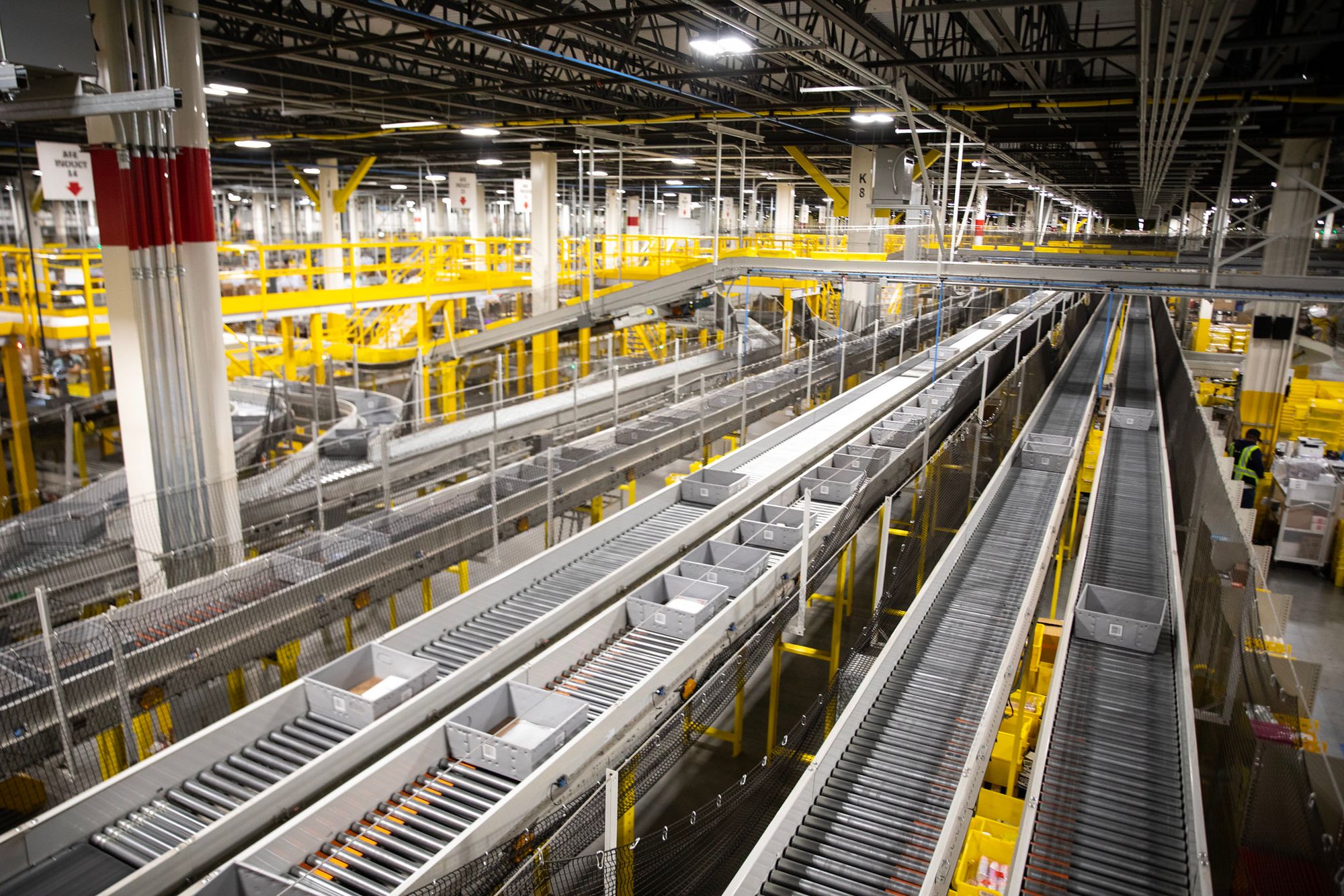Last week, the Workplace Safety and Insurance Board (WSIB) in Ontario released new data that shed light on occupational injuries at Amazon’s Canadian facilities. The figures, grotesque if not entirely surprising, demonstrate the physical and financial consequences of work intensification at the online shopping and warehousing giant. In some respects, however, the numbers obscure as much as they reveal.
According to the WSIB, Amazon Canada Fulfillment Services, the corporate entity that operates Amazon warehouses in Canada, recorded more than 1,300 workplace injuries in 2022, resulting in nearly more than $4.4 million in disbursed benefits to workers. These are not insignificant totals, but they require some unpacking.
The likely retort from Amazon — company spokespeople have said as much in the past — is that their ‘injury rate’ in Canada is comparable to their competitors. Indeed, Amazon Canada doesn’t seem to have workplace injury claims far in excess of other warehousing facilities, at least as far as the figures available online through the WSIB indicate. According to the Board’s data, while Amazon’s injury rate outpaced its competitors in 2012 (the first year of available data), from 2013 until the pandemic, its injury rate was below the industrial average in warehousing. Injuries at Amazon have spiked from 2020 onward, but even still, its 1.65 injury rate (per 100 full-time equivalent workers) brings it just under the peak industry average reached in 2018.
However, the injuries in the WSIB’s dataset represent only those claims that made it to the Board. For a variety of reasons — workers too afraid to complain, managers pressuring employees not to file a claim, workers accepting injuries as a ‘normal’ part of their job, etc. — many injuries go unreported. The same is true for virtually all employment law violations: power imbalances in the workplace systematically impede workers from asserting their rights.
Consequently, pinning down Amazon Canada’s true injury rate, and making comparisons with its competitors, is a challenging endeavor. In 2020, Sara Mojtehedzadeh at the Toronto Star published an investigation into Amazon’s occupational health and safety record in Canada. She found that, according to internal records obtained by the Star, injury rates were worse in Canada than in the United States, where the company’s dismal record was garnering media attention. She also found that, in 2019, Amazon’s injury rate across Canada was 9.1 per 100 workers, higher than in the U.S where an Occupational Safety and Health Administration investigation revealed an injury rate of 6.8 per 100 workers for 2021. The Star investigation additionally showed that the injury rate at Toronto-area facilities had doubled over the course of four years.
As Mojtehedzadeh’s probe also revealed — and has since been confirmed by U.S. OSHA officials — Amazon systematically suppresses its reported injury rate. The company routinely contests the validity of injury claims to the WSIB, often contending that workers have no proof that accidents or injuries resulted from their work. This is common when occupational injuries have no clear starting date. For example, it’s difficult to determine the onset of the sorts of repetitive motion injuries common in warehouses. Underreporting occupational injuries is a widespread problem, but Amazon seems to be an especially guilty culprit.
It’s therefore safe to say that the Amazon figures reported by the WSIB in Ontario are only the tip of the iceberg. Yet, even putting this aside, the data is noteworthy. For starters, since the beginning of the pandemic, Amazon fulfillment centres have greatly expanded their workforces in Canada. In Ontario alone, the company claims it has added more than 12,000 employees (though it now indicates that mass layoffs are coming globally). Consequently, an official injury rate more or less in line with other firms in the Canadian warehousing sector glosses over what is a startlingly high total number of injury claims.
Since the pandemic, injuries at Amazon have ballooned. In 2017, Amazon Canada recorded 98 workplace injury claims. By 2019, this figure had risen to 432. In 2021, 980 injury claims were made. Last year, Amazon workers filed 1,333 claims. As a result, the more than $4.4 million in benefits paid to injured Amazon workers was roughly four times the total disbursed in 2019. In all, workers’ compensation payments have totaled more than $8.5 million since the pandemic began.
Workers’ compensation systems are based on an insurance model where employers pay premiums based on how ‘risky’ their industries and businesses are (i.e., how many injuries or accidents workers sustain). More accurately, risk, and therefore premiums, are calculated according to how many worker claims make it to the Board. In theory, the system is meant to incentivize employers to improve their health and safety practices, procedures and records. In practice, however, the model also incentivizes employers to hide accidents and pressure vulnerable workers not to submit claims.
Prior to 2020, we also know that Amazon was catching a huge economic break when it came to WSIB premiums. Up until the pandemic, the WSIB classified Amazon as part of the relatively less risky “bulk retail” sector rather than as a warehousing operation, in the process cutting its premium payments considerably. While no exact figures are available, it’s not inaccurate to characterize this misclassification as a sizable payroll tax break for the company. Luckily that has since been revised, surely in response to the increased incidence of workplace injuries at Amazon warehouses.
Additionally, Amazon’s overall injury rate obscures a much higher rate of injuries that didn’t result in workers taking time off the job. In the WSIB’s data, occupational injuries are broken down according to whether “lost time” occurred. While Amazon recorded a “lost time injury rate” of 1.65 last year, its “no lost time injury rate” was 3.33, just below its peak of 3.50 in 2019 but well above its low point of 0.78 in 2014.
Lastly, these figures only cover Amazon’s warehouse fulfillment centres, not its network of subcontracted “delivery service partners” who are also notorious for their harsh working conditions and widespread employee misclassification.
As Mitchell Thompson at PressProgress reports, worker advocates argue that hazardous working conditions and intense pressure at Amazon warehouses contribute to the risk of workplace injuries. A business model that prioritizes same- and next-day shipping and delivery necessarily entails strenuous working conditions and inhumane productivity targets at both fulfillment centres and in delivery vans. Under these conditions, workplace health and safety are an afterthought, despite Amazon’s assurances to the contrary.
Last year, incoming Amazon CEO Andy Jassy vowed to improve the company’s safety record in his first letter to shareholders. Since then, the company’s initiatives have been lacklustre. For example, Amazon has introduced wearable devices in some facilities that supposedly notify workers when they are moving in an unsafe way. Hardly a promising intervention. It has also partnered with the U.S.-based National Safety Council, a non-profit safety advocacy organization, in an effort to analyze work practices and prevent injuries. This non-profit in no way has the power to compel Amazon to change corporate policy; it simply advises. In fact, what is common to all of Amazon’s safety interventions is that they rely on the company policing itself — or downloading that responsibility onto individual workers.
Corporations can’t police themselves, that much should be clear. Amazon workers need the protection, independence and empowerment that only unionization provides — and ever since an upstart union in Staten Island had the audacity to take the company on, we’ve gotten a clear picture of how far Amazon is willing to go to fight unions.
Short of unionization — which is a time-consuming though necessary process — stronger regulatory interventions could also play a role in forcing Amazon and similar employers to reduce work intensity and workplace injuries. California’s Assembly Bill 701, the ‘warehouse quota law,’ is a good model from which to start. The bill requires warehousing employers to inform workers of all productivity quotas in a transparent way and stipulates that quotas can’t interfere with rights to meal and rest periods or violate health and safety laws.
Of course, regulatory interventions require strong enforcement and are never pure substitutes for a union. However, stronger policy and collective power are the only way to bring a company like Amazon to heel.







